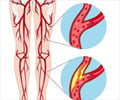Research presented today shows angioplasty and stenting can prevent amputation and restore blood flow in the lower extremities of patients with severe critical limb ischemia and gangrene.
Research presented today shows angioplasty and stenting can prevent amputation and restore blood flow in the lower extremities of patients with severe critical limb ischemia and gangrene (tissue loss). At eighteen months, the tiny arteries below the knee remained open, with a ninety-one percent success rate, thus preventing amputation. This success rate was consistent in all patients who were consecutively enrolled over a six-year period of time. The blockages were caused by peripheral arterial disease (PAD), “hardening of the arteries,” the same disease which can lead to heart attack and stroke. The smaller blood vessels below the knee are more difficult to treat due to their size (3mm) and are more prone to reclog than larger vessels.
“This study shows that with angioplasty and stenting, we can restore blood flow through the smallest vessels in the legs and keep them open long-term, saving these patients from life-altering amputation,” says lead author Nael Saad, M.D., interventional radiologist, University of Rochester Medical Center, Rochester, New York. “Aggressive interventional therapy should be considered in all patients as a first option. In general, the long-term clinical results are comparable to by-pass surgery in the leg using a longer, more complex graft, but with a much lower risk of morbidity and mortality.”About Peripheral Arterial Disease
Peripheral arterial disease (PAD), also known as peripheral vascular disease (PVD), is a very common condition affecting 12-20 percent of Americans age sixty-five and older. PAD develops most commonly as a result of atherosclerosis, or “hardening of the arteries,” which occurs when cholesterol and scar tissue build up, forming a substance called plaque inside the arteries that narrows and clogs the arteries. PAD is a systemic disease – clogging in one area of the body (legs) indicates clogging is occurring in other parts of the body (heart).
* PAD is a disease of the arteries that affects ten million Americans
* PAD can happen to anyone, regardless of age, but it is most common in men and women over age fifty
* PAD affects 12-20 percent of Americans age sixty-five and older
About Angioplasty and Stenting for Treating PAD
Using imaging for guidance, the interventional radiologist threads a catheter through the femoral artery in the groin to the blocked artery in the legs. He then inflates a balloon to open the blood vessel where it is narrowed or blocked. In some cases, this is held open with a stent, a tiny metal cylinder. This is a minimally invasive treatment that does not require surgery, just a nick in the skin the size of a pencil tip.
In general, balloon angioplasty and stenting has replaced invasive surgery as the first-line treatment for PAD. Randomized trials have shown interventional therapy to be as effective as surgery for many arterial occlusions and, in the past five to seven years, a very large clinical experience in centers throughout the world has shown that stenting and angioplasty are preferred as a first-line treatment for more and more processes throughout the body. Although PAD in general is treated nonsurgically, in many cases the superficial femoral artery is still being treated surgically.
Source-Newswise
SRM






